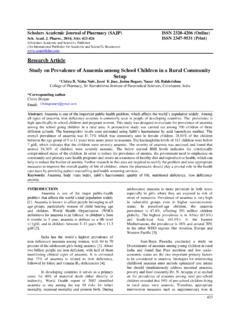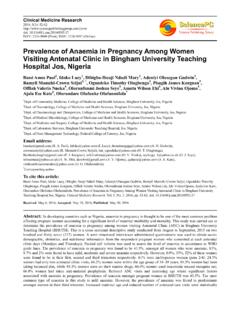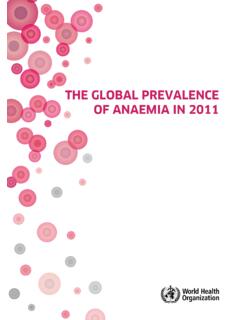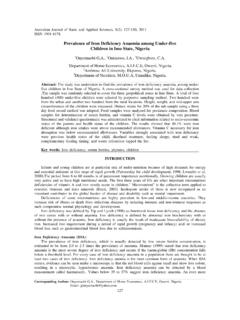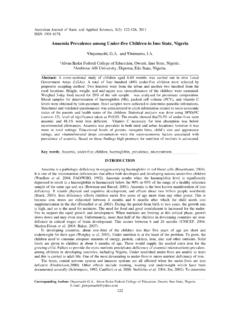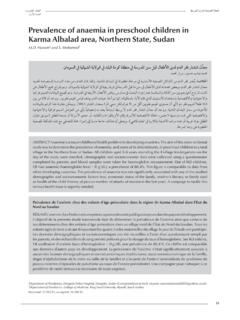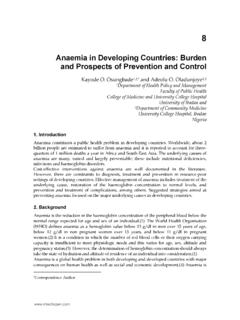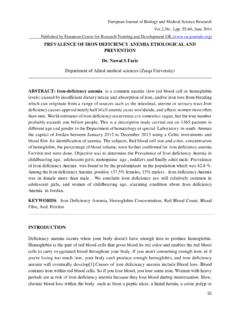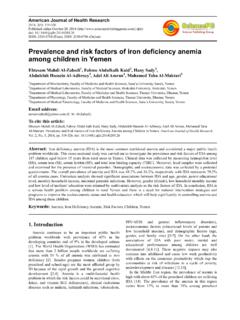Transcription of Journal homepage: www.mcmed.us/journal/abs TYPES OF ...
1 Venkatesh G et al. / Acta Biomedica Scientia. 2015;2(4):226-228. Research Article 226 e - ISSN - 2348 - 2168 Print ISSN - 2348 - 215X Print ISSN - Acta Biomedica Scientia Journal homepage: TYPES OF anaemia AMONG UNDER FIVE CHILDREN ADMITTED TO MEDICAL COLLEGE HOSPITAL: A DESCRIPTIVE STUDY Venkatesh G1*, Soubhagya Talawar2, Bela H Shah3 1Ex Junior Resident, Department of Pediatrics, BJMC Ahmedabad, Gujarat, India. 2Ex Junior Resident, Department of Obstetrics and Gynecology, KIMS Hubli, Karnataka, India. 3 Additional professor, Department of Pediatrics, BJMC Ahmedabad, Gujarat, India. Article Info Received 29/07/2015 Revised 16/08/2015 Accepted 19/08/2015 Keywords :- Iron deficiency anaemia , Under five children, Haemoglobin.
2 ABSTRACT anaemia is a major public health problem in developing countries, contributing significantly to morbidity and mortality in children under five years. About 43% of children under five years are anaemic worldwide . Even where blood transfusions are available there is a significant case fatality rate of 6 18%. This study aimed at determining the prevalence of anaemia as well as morphological TYPES of anaemia among children under five years admitted at tertiary care hospital. Iron deficiency anaemia was more common. INTRODUCTION anaemia can be defined as a reduction in the hemoglobin, hematocrit, or red cells number.
3 In physiologic terms, anaemia is any disorder in which the patient suffers from tissue hypoxia due to decreased oxygen carrying capacity of the blood [1]. It is mainly caused by iron deficiency in all developing countries, including Africa, where consumption of iron is limited. This is because iron-rich or animal based foods are not affordable by most families. Children <2 years and pregnant women are most at risk for anaemia because their requirements for iron are higher than any other group [2]. anaemia is said to be a severe public health problem when its prevalence is 40% or more in any group (all TYPES of anaemia ).
4 Severe anaemia (haemoglobin < 7 g/dL) is a public health problem if prevalence exceeds 2% [2]. According the 2004 World Health Organization (WHO) report, more than 2 billion people worldwide are Corresponding Author Venkatesh G Email: - anaemic and about of preschool children are affected by the problem. It affects most of countries in Africa and South Asia and some countries in East Asia and the Pacific. The highest prevalence of anaemia is in Africa, but the greatest numbers of children affected are found in Asia [3]. Furthermore, according to 2008 WHO report, more than half of the world s preschool-age children ( ) reside in countries where anaemia is a severe public health problem [3].
5 About half of the population in the developing countries has iron deficiency anaemia . Preschool, school and adolescent children and women in childbearing age are at increased risk. Iron deficiency anaemia affects 30% of the world population [7,8]. The prevalence of anaemia among children under 5years of age is estimated to be about 20% in industrialized countries and 39% in non-industrialized countries [9]. Iron deficiency anaemia is a leading cause of morbidity and mortality worldwide [7]. In India, the national program for prevention and control of anaemia focuses on pregnant women and young children less than 5years.
6 However, the status of anaemia in children is not well documented [7]. Venkatesh G et al. / Acta Biomedica Scientia. 2015;2(4):226-228. Research Article 227 METHODOLOGY A descriptive study was carried out in a tertiary care hospital to know the pattern of anaemia . Children of age group less than 5 years were the study subjects and amongst them patients having severe anaemia Hb < 7 gm% (WHO Grading) were evaluated as per Performa. Patients having mild and moderate anaemia are excluded. Patients having severe anaemia due to haemolytic anaemia , malaria, aplastic anaemia and patients expired due to congestive cardiac failure within 12hrs of admission.
7 Detailed history regarding diet and socioeconomic status of family and presenting symptoms and signs, detailed anthropometry recorded. Venous blood was collected in a Wintrobes bulb for haematological investigations. Peripheral smear was taken simultaneously. PCV, MCV, MCH, MCHC, RDW were determined by automated cell counter. Iron deficiency anaemia diagnosed in patients having low PCV, low MCV, low MCHC, increased RDW, decreased serum Iron and increased TIBC and peripheral smear suggestive of microcytic, hypo chromic picture. Megaloblastic anaemia was diagnosed in patients having decreased PCV, increased MCV, normal or decreased MCH, normal to decreased MCHC and peripheral smear suggestive of macrocytosis.
8 Dimorphic anaemia was diagnosed as decreased PCV, normal or decreased or increased MCV with decreased or normal MCH, normal or decreased MCHC, normal or low or increased RDW and peripheral smear suggestive of dimorphic picture. Normal value for PCV is 35-45%, for MCV 77-95fl, for MCH 25-33pg, for MCHC 31-37gm/dl and RDW Data was entered in a Microsoft excel and was analysed using SPSS. RESULTS AND DISCUSSIONS Iron deficiency anaemia is most common in our study followed by dimorphic anaemia and megaloblastic anaemia , which is in accordance to previous studies [10,11,12,13,14].
9 There are several causes of iron deficiency anaemia . The principal cause in children in developing countries is inadequate intake of usable iron, which is normally found in a well-balanced diet in the form of heme and non-heme iron. Several well controlled trials have been effective in reducing the prevalence of anaemia in school-age children. Fortification is an attractive option for controlling iron deficiency anaemia in countries where a significant number of groups are vulnerable to an ever increasing consumption of centrally processed foods [15]. Maximum number of patients were presented with fever while, presented with easy fatigability/weakness, were presented with cough.
10 It is observed that maximum number patients admitted at our institute have some or other form of infectious disease. Very few patients were admitted for only anaemia . Many patients had two or three type of infections on admission so there is overlapping of percentage in symptom logy. Worm infestation present in and pica in , it shows correlation between pica and worm infestations. Present study shows pica in while in mahendra et al it was 31%. In the current study fever is the most common symptom followed by weakness, cough etc. This is in accordance to previous studies [9, 10, 11].
